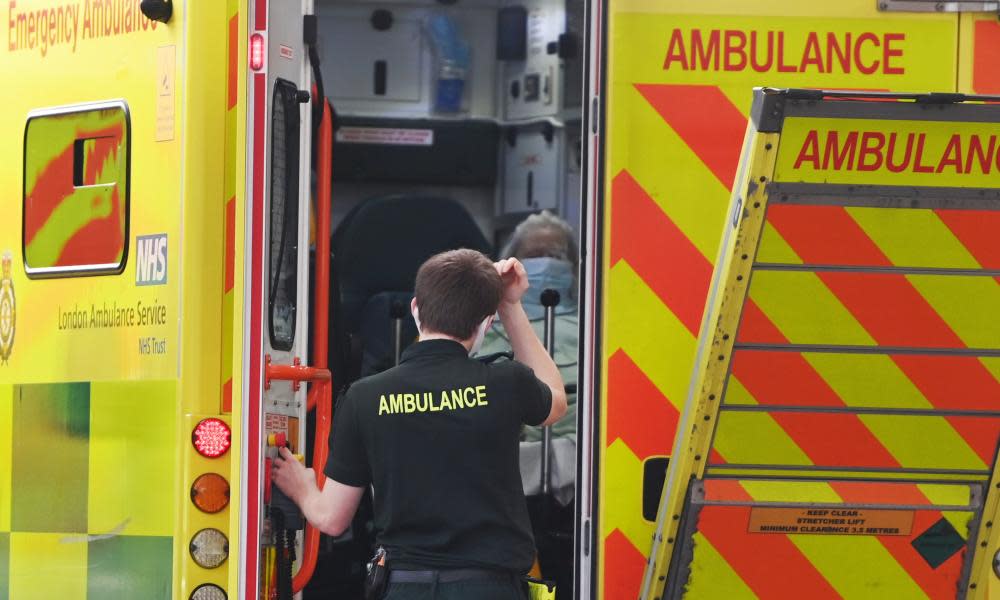I am a paramedic trying to answer your 999 calls. Let me tell you about life in the NHS twilight zone

There’s a corridor at my local hospital that has become very familiar to me. It runs from the ambulance entrance to the initial assessment area in A&E. Patients sit in a line on wipe-clean chairs underneath posters about hand hygiene and mask-wearing. I think of this corridor as the twilight zone, a place where time evaporates, because this is where ambulance crews are now waiting for hours, day and night, Monday to Sunday, with their patients on trolleys to be called into the emergency department to hand over.
The news that ambulance crews are experiencing delays at hospital of up to 40 hours is shocking. Every year we hear about the latest challenges facing the NHS, but these problems are now so common they feel routine. We used to talk about winter pressures, but those pressures now seem to be year-round. When I started in the ambulance service more than a decade ago, I would expect to see nine patients in a shift, allowing for journey times, assessment, treatment and handover; that figure is now more likely to be six – on a good day.
The consequences for patients are clear: physical discomfort, emotional distress and the potential for deterioration. Critically ill patients are brought into hospital on blue lights and with a pre-alert to ensure they’re seen immediately, but there are plenty with non-life-threatening conditions for whom that wait in the corridor, or on the back of an ambulance, will have insidious consequences, such as delayed recovery. The reality is that these same patients have probably experienced long waits for the ambulance to arrive in the first place, because crews delayed in hospital corridors mean fewer resources available to respond.
It’s sometimes suggested that ambulances should be able to offload their patients into an intermediate monitoring zone while they wait to gain access to A&E. This strategy is used in some hospitals, and has the benefit of freeing up ambulances to become available again, but it effectively creates another cohort of patients waiting to be seen – without any extra staff – and when the ambulance crew return with their next patient, the same issue recurs.
In some areas, ambulances are instructed to bring patients to quieter hospitals to improve flow: the theory is to spread demand and reduce waiting times, though the system tends to be unpopular with patients, who can end up being taken to locations far from home. For ambulance crews out on the road, such measures feel like well-intentioned tweaks, rather than a genuine attempt to address the central problem: a lack of capacity.

There are some causes for optimism. Since the pandemic, clinicians from different areas of the health service are more familiar with each other’s roles, meaning it’s now easier for ambulance crews to refer their patients to services in primary care and avoid unnecessary hospital admissions. Alongside this, new clinical pathways have been developed, such as same-day emergency care services, which filter appropriate patients away from A&E and into targeted clinics. Sometimes it takes time for the benefits of such changes to become apparent.
Recent reports have highlighted the impact of delayed discharges. The temptation is to conclude that patients should be packaged up and discharged as soon as they’re fit, but the scale of this undertaking only becomes clear when you see patients in the community. This week I attended an elderly woman who’d been discharged home after a fall and surgery on a fractured hip. Yet the necessary support and equipment had not been arranged prior to discharge, and as a result the patient, who lived alone, ended up being readmitted to hospital until appropriate arrangements could be made.
Related: Navigating the NHS: How patients are affected by delays
With government recently announcing an injection of discharge funding for hospitals in England, it’s worth remembering that the social situation a patient is discharged home to is often the same one that triggered a hospital admission in the first place.
The emergency healthcare system may be a victim of its own accessibility. Ambulance services in England have accepted the increase of low-acuity calls they receive and now operate as providers of both emergency and urgent care, taking just 51% of patients to A&E in October, while resolving 33% of incidents on scene and 12% via telephone. Emergency departments have experienced similar behavioural changes, with 24.4 million A&E attendances in England in the year 2021-22, and 47% of those attendances by under-35s.
Many patients now choose to self-present at A&E over GP attendance – perhaps due to problems getting an appointment, perhaps through a lack of awareness of available services, perhaps through simple convenience. But, just as ambulance services now struggle to meet the needs of their sickest patients due to the encroachment on the emergency system of patients with minor complaints, it’s easy to see why understaffed A&Es are struggling to cope with demand.
As the NHS prepares to face a uniquely challenging winter, it’s incumbent on those in power to ensure that such vital services are sufficiently funded and clinicians are properly supported, so that patients are not left waiting in the twilight zone.
Jake Jones is the pseudonym of a paramedic and the author of Can You Hear Me? An NHS Paramedic’s Encounters with Life and Death
Comments on this piece are premoderated to ensure discussion remains on topics raised by the writer. Please be aware there may be a short delay in comments appearing on the site.

 Yahoo Movies
Yahoo Movies 
